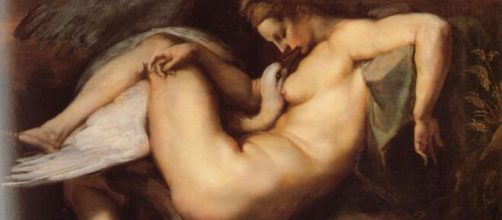While “Sex and the City,” the popular TV series about women’s private lives in Manhattan, debuted in 1998, there’s a far earlier version in Pompeii that is far more explicit.
Consider the murals of ancient Rome, where graphic sex scenes were plastered over walls and ceilings not only in taverns and bathhouses but also in private homes. Pompeii Archaeological Park is now showing 70 examples.
Of course, few can claim shock at Old Rome’s raunchiness given all the steamy scenes on our silver screens. But one of the exhibit examples featured on CNN – "Leda and the Swan" – disturbs the heck out of me.
Archaeologists found this mural on a bedroom ceiling buried under volcanic ash – the result of Mount Vesuvius erupting in the 1st century AD. It should have stayed buried. Now, after nearly two millennia, you can see the god Zeus in the guise of a swan seduce Leda, the Queen of Sparta as she bathed in a river.
What’s wrong with this picture?
What does this scene say about female sexuality when a woman so readily responds to the overtures of a sea bird? And what does it say about a male who uses subterfuge to get what he wants?
Granted the sex between a woman and this bird of prey didn’t actually occur. It comes from an ancient myth. But too many painters and sculptors have sought to beautify the pairing for me to join in the celebration of the archaeologists’ discovery.
The list of artists who painted this tale is long, including Leonardo da Vinci, who pictured Leda looking utterly charmed by the swan’s advances. (By the way, Leda also wears the same secret smile seen in his "Mona Lisa," which he was painting at the same time).
Michelangelo also showed Leda smiling, in her case as the swan nestled between her legs readying for a kiss. Peter Paul Ruben liked that image so much, that he copied it.
Granted the ancient Romans were a callous lot but were Da Vinci, Michelangelo, and Rubens, too? Who knew?
At least W. B. Yeats didn’t see the myth as loving. In his sonnet “Leda and the Swan,” he recognized that the female was taken by force with these words:
“A sudden blow: the great wings beating still above the staggering girl…her nape caught in his bill, he holds her helpless…”
Clearly, Yeats anguishes about Zeus’ bestiality when he asks, “How can those terrified value fingers push the feathered glory from her loosening thighs?” My question, exactly, though admittedly not as lyrically put.
Then there’s Yeats’ killer last line that nails Zeus’ heartlessness. After he has his way with her (and impregnates her (“a shudder in the loins”) he writes how his “indifferent beak lets her drop.”
While Yeats saw the mythical tale as a rape, as a violation dealt in a violent assault, painters like Da Vinci and Michelangelo rendered the brutality picturesque.
Worst case scenario
But wait, Cezanne’s version of the myth goes so far as to make Leda out to be some wanton female who lolled around without a stitch petting the swan’s beak. Really, Paul?


